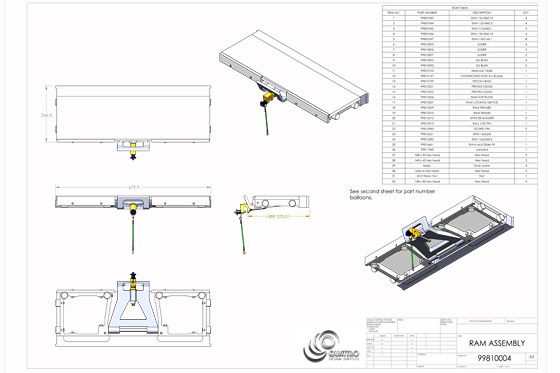Projects
Dough Chunker Assembly
A problem we were asked to solve, is that our client had a very large infeed hopper on top of their machine capable of holding up to 1 ton of product (in this case was bread dough), causing the machine to trip and fail, due to the mass of product bearing down on the pushing ram.
So we designed a piece of equipment that goes between the large hopper and machine, it dispenses smaller chunks into the lower smaller hopper and keeping most of the weight above the cutting blades.
The two cutting blades come together to cut the dough, they index 1/3 of a turn at a time, when a cut is complete the blades stay in a horizontal position, keeping the mass of product above and closing off the gap to the hopper below.
Vegetable Handling Assemblies
In the vegetables handling industry, we needed to come up with a way of removing the centre cores and then dividing the remainder into quarters.
On the core remover assembly, we piggy backed two pneumatic cylinders, first cylinder operation is to cut the core from the vegetable (in this case cabbage approx 12-14″ dia) the second cylinder operation rejects the already cut cores that remain in the cutter unit itself, dispensing them onto retracting chute arrangement.
The next station along the machine is where we cut up the cabbage into quarters, again there are twin heads to slice up two vegetables at a time.
Bowl Feeder
See images of some small parts which were orientated in vibratory bowl and linear feeders. Product size isn’t really an issue.
I spent 16 years with the leading automation companies in the UK, designing and integrating complex assembly machines. Over the years have designed and tooled over 800 Bowl feeder. Notably, I co-designed the company’s first-ever camera vision system, enabling the orientation of components entering the tooling bowl and linear feeders to be checked and defects identified at pace.
Bowl feeder sizes depends on a number of factors, speeds (parts per minute) and how long between refills are just a few considerations, additional bulk storage hoppers can be added to increase time between refills, these are operated by a product level sensor either a paddle type switch or reflective sensor looking into the bowl feeder, bulk storage hoppers trickle feed the parts to the bowl feeder, once the desired level in the bowl is reach the sensor will switch off the hopper unit.
Bulk Storage
See some examples of previous designs for bulk storage equipment.
Bulk hopper with conveyor outfeed.
Biomass wood pellets hopper with screw auger outfeed, Access to the installation area was a big factor.
The main restriction was the door at the base of the stairs, knowing these dimensions the design was based on a modular configuration.
Bulk storage wood chipper consisting of Hopper, pneumatic push cylinder and driven rotating cutter blades.
Seaweed Processing line, consisting of washer unit, cutter unit. elevator and then warm air drier housing.
Selection of Feeding and Screening Units
This style of Feeders/Screens use vibration to move materials from one process to another, loosening or spread material.
Using coil springs to stop vibration transmission onto support frames for example
Screening units have mesh panels fitted so that it allows small product to fall through the openings onto lower deck as to separate product in to various grades, or for de watering.
Made from Mild steel or stainless steel.
Screens made of mesh wire, perforated plate, polyurethane panels, wedge wire.
Wear interchangeable resistant liners can be added for heavy duty materials.
Can be open to fully enclosed.
Custom made designs to fit when spaces and feed rates.

2D CAD Drawings
We produce high quality fully compliant drawings which include:
• Concept Drawings
• Fabrication Drawings
• Manufacturing Drawings.

3D CAD Service
We offer CAD services for important projects and take pride in the delivery of the final designs we create for our clients.

CAD Conversion
We take your ideas, whether its just a hand sketch or other formats and turn them into a drawing and 3D model, bringing them to life.

Rendering
Is taking the 3D model to the next step, by generating it with realistic graphics, by applying material, texture and also adding lighting and background scenes.

Reverse Engineering
The process of Reverse Engineering is to take an existing product apart to see how it works for the purpose of duplication or enhancing the object.
